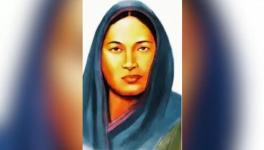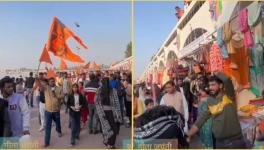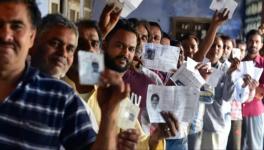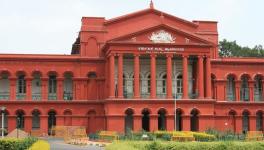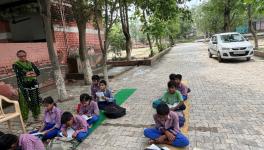The Bhagana Power Games
The gangrape of the four Dalit girls in Bhagana is a brazen cocktail of caste, crime and feudal mindsets.
On April 17, the day India was polling at 121 constituencies in the fifth phase of the ongoing General Elections, four girls and 100 families from their community parked themselves in protest in central Delhi.
These four girls were gang raped on March 24, this year and belong to the Dalit community of Bhagana village, in Hisaar, 150 km from Delhi. Dalits are regarded as untouchables and occupy the lowest rung in the Hindu hierarchical order. They have been identified under the Scheduled Caste category in the Indian constitution.
Huddled in an unhindered mass under three tents behind Jantar Mantar, there is an unfamiliar spring in their demeanor. Far less demure than the stereotypes of rape survivors, they are brimming with hope and the glow of a persistent, collective struggle.
The only Dalit square in the village which was razed by the Jat community and led to protests.
“I was revising my lessons while going for a dump that evening. I had to sit for the English exam the next day,” recalls Manju, 13, a student of sixth standard, one of the four girls, with the characteristic assertion of a teenage girl. Close to 60 percent of the households in Bhagana village still don’t have a toilet. Daily, early in the morning or late in the evening, women collect in groups to go to the agricultural fields to defecate. It is then, she along with three other girls were abducted and forced to sniff something that made them unconscious. Out of the five who abducted them, four were relatives of the leaders of the dominant Jat community in Bhagana. Sunita, then in her half unconscious state was stripped, beaten and raped by the boys one after the other. They did the same to the other three girls. “I could barely open my eyes, forget resisting the boys,” she says.
Their next memory is of the Bhatinda railway station, a city 150 km away from Hisaar. Their clothes were torn, had injury marks on their bodies and walked in pain. “I asked people on the platform if they knew who left us there but since they spoke in Punjabi, a language I am unfamiliar with, I didn’t get them,” recalls Ranjana, 18, with a newly acquired maturity. Sunita, 16 and Kamini, 17 sit behind them and listen intently. The four are surrounded by their mothers and women who look at me disapprovingly. “What is the point of you coming here? We have been sitting in this heat for a month but still to no avail. I thought protests in Delhi lead to result like the Damini case,” asked Laajo Rani in a Haryanvi dialect. She is 80 years old. I tell her, “It is because of the ongoing elections.” She answers, “So, don’t we vote and make winning candidates?” Guilt overtakes and I turn to Manju.Manju is dressed in a white salwar kameez with pink dots and a crimson scarf. The scarf is comfortably settled on her head out of habit, like many girls her age in rural Haryana yet she constantly struggles to tuck it behind her ear to cover her face from the photojournalists outside the tent. “We had to drop out two years back, she was the only one still managed to go to school,” joins Ranjana.
Bhagana village is 300 years old. The houses of the four girls are diametrically opposite to each other on the outskirts of the village. Bhagana is dominated by the feudal, land owning Jat community that makes up for 59 percent of the village population. Dalits, which include several sub categories like Dhanuks, Chamars, Kumhaars and others, make up for the 24 percent population. They are landless and mostly work as agricultural labourers in the farms of Jat community. They are also considered untouchables. People from the upper castes, including the Jat community, neither eat or drink at their place nor are they allowed to sit next to an upper caste person.
In March 2012, the Jat community under the leadership of Panghal Khap-the one of the many clans of the community to which all the Jats of the village belong, announced a ‘bandi’ on the Dalits of the village. ‘Bandi’ is a social and economic boycott. This was a response to the Dalit protest against the decision of the constitutionally elected panchayat headed by Rakesh Panghal, also a Jat, to allocate the common land of the village to members of Jat community. This included the playground on the outskirts, close to the Dalit inhabitation and the Dalit meeting square in the centre of the village. “In addition, the common ground that was divided into plots to be given away to villagers was given for free to the members of the Jat community but not to the Dalits even when they were forced to pay Rs 1,000 each for allocation,” says Balraj Sindhu, a Dalit member of Centre for Trade Union from the village. There was a massive protest by the Dalits within the village against this injustice which did not sync with the Jat-Dalit traditional power equations in the village. “They dissented against those who gave them employment and means for survival. Such people must leave the village,” says Kundan Panghal, a Jat farm owner and activist of the Panghal Khap.
The boycott included a ban on the use of all common resources in the village including water resources like wells, barbers, local transport, grocery shops, schools, access to cattle feed, access to roads passing through the Jat areas and employment in the agricultural fields.
Like several parts in Haryana, there is an existing labour practice in Bhagana village which is called Seeri. Under the Seeri system, an agricultural labourer is hired by a land owning farmer on an annual contract for close to Rs 40,000 per year, which comes to about Rs. 110 a day, way below the minimum wage of Rs. 230 a day in Haryana. They are paid the money in advance and are bonded for a year. Apart from the agricultural work, the labourers are often made to do other household related work with no fixed hours. In 1953, the Punjab Security of Land Tenures Act was implemented in Haryana which provides complete security of tenure for tenants in continuous possession of land over 15 acres for 12 years and grants tenants optional right of purchase of ownership of non-resumable land. The Seeri system negates the possibility of the proof of continuous occupation of the land as a tiller since the contracts are renewed every year. “Off late, the labourers had started rejecting the exploitative practices under Seeri like no fixed hours of work and the extra work apart from agriculture that the employers forced them to do,” says Sindhu. This was not just a threat to the age old social hierarchy in the village but was also disturbed the economic privileges the farm owning Jat employers enjoyed.
“The next two months, we tried very hard to stay. Even NREGA programs which could have given us employment in spite of the boycott have not been functional in the village,” recalls Dharamveer, a 40 year old Dalit mason. NREGA is the Central government sponsored scheme that guarantees 100 days of employment to all. “On May 21st, when the Jat community announced another ‘bandi’ with even stricter norms, 137 families decided to move to the mini secretariat in Hisaar district to demand action from the authorities,” he adds.
The playground next to the Dalit inhabitation is now used for storing cow dung by the Jat community.
Two years have passed and to this day, close to 90 families still occupy the protest spot in Hisaar but no action has been taken. During this period, the police failed to register even a single complain under the Scheduled Caste and scheduled Tribe (Prevention of Atrocities) Act. To add to it, in September 2012, the police booked a few people protesting at the Mini secretariat for sedition and ‘exciting disaffection towards the government established by law’ and imprisoned them for a week. This included five children, 8, 9, 10, 12 and 14 years old along with three adults.
Meanwhile, the hostility towards 200 Dalit families still left at the village had increased manifold. The worst affected were the women because all the things boycotted were directly related to the household. “Apart from fetching water from far off and managing groceries with limited access, the biggest loss was lack of employment for us. Because of the ban imposed on our community as agricultural workers, the men could go to the city and neighbouring villages to work but women were confined to their homes,” says Rattal Sindhu, 55, grandmother of three who has been an agricultural labour for thirty years in this village. “In most of the houses, the household income has been halved,” she adds.
The schools did not remain untouched. There are two schools in the village, a private one which the children of the Jat community, who could afford to pay high fees attended and the government one, attended mostly by the children of the Dalit community. “After the boycott in 2012, many girls had to drop out because of the eve teasing they had to face while coming to the school. It has increased in the last two years. Some Jat boys enrolled in the school would kick our boys and humiliate them,” tells Satya Narayan, the headmaster of the government school. “I even threatened to shut the school but not allow this kind of discrimination but it did not help. As the protest at Hisaar kept catching headlines in the media, the aggression and enmity towards the Dalit kept increasing in the village,” he adds. Manju was still a student of this school, the other three had drop out in 2012. The news of their gang rape was the last nail in the coffin. After another set of 100 families moved to Delhi to protest, the school is lying vacant. The only Dalits left here are still bonded under Seeri, who under pressure of the Jat community have stopped sending their children.
On 24th March, while the girls were figuring out how to go back home from the Bhatinda railway station, they saw the village head Rakesh Panghal walking towards them with three influential Jat leaders. “The night the girls went missing, we went to Rakesh to inform him and ask for help. He told me that our girls will be back tomorrow morning. He knew where the girls were which was shocking,” says Bheem Singh, father of Ranjana. Next morning, the fathers of the four girls and Rakesh Panghal and some others got into two jeeps and reached Bhatinda railway station.
Panghal reached the exact platform where the girls were waiting. When the girls saw him, they first tried to hide. “It is only when we saw our fathers on the other platform with the aides of Panghal is when we came out,” says Kamini. The four girls were rushed into a car with Panghal and their fathers. On the Mirzapur road, the car was stopped at a roadside café. The girls were seated on the first floor as the others had tea on the ground floor. Rakesh Panghal walked to the first floor with his uncle and slapped Sunita. “Your community people think that they can contest the Jats? What was done to you is a lesson for raising a voice against us. If you dare complain against anyone or identify any of the boys, your families will be killed,” says Manju. Soon after, they left for the village. The next day, the four girls, their fathers and some members of the Dalit community reached the police station. On March 25, after a lot of struggle and protest, the police registered a report for rape and medical tests that confirmed rape were conducted. The five accused Sumit, Lalit, Sandeep, Dharamvir and Kuldeep-all of them Jats-were arrested on March 29. The next hearing is in the Supreme Court of India on May 7th.
Rakesh Panghal, when asked about the accusations of the Dalit community replies, “These girls are known to have multiple love affairs. How can they be trusted?” When asked about the illegal allocation of the land and the social boycott, he says, “They are all lying. They have left their houses on their own to extract unjustified compensation from the government.” The same justification was given by influential Jat leaders when the houses of several Dalits were burnt and two were killed in the Mirchpur village of Hisaar district in 2010.
Kaviraj, the Superintendent of Police, Hisaar district says, “The police has taken every care to follow legal proceedings. I cannot comment anymore since the case is now subjudice.”
ML Kaushik, the District Collector of Hisaar also remains non-committal. “The people sitting in protest have been politically motivated. We have requested them to return to their houses but to no avail,” he says.
According to the National Crime Record Bureau, the number of rapes of Dalit women across the country has increased by 15.4 percent in one year. Only one in eight cases of atrocities on Dalits, a person gets convicted in Haryana.
In 1931, when Mahatma Gandhi asked BR Ambedkar, the champion of Dalit rights and the father of the Indian constitution why is he so critical of the Congress, the leading party in the freedom movement, demanding an independent homeland, he replied, “ Gandhiji, I have no homeland. No untouchable worth the name will be proud of this land.”
As India is set to conclude the greatest dance of democracy on May 16, Dalits- who represent 16 percent and women-who represent 48 percent of the Indian population still need to struggle at Jantar Mantar. Explains what Ambedkar meant.
Names of the Rape Survivors have been changed.
(A shorter version of this article was originally published in New York Times on 29th May 2014)
Get the latest reports & analysis with people's perspective on Protests, movements & deep analytical videos, discussions of the current affairs in your Telegram app. Subscribe to NewsClick's Telegram channel & get Real-Time updates on stories, as they get published on our website.









